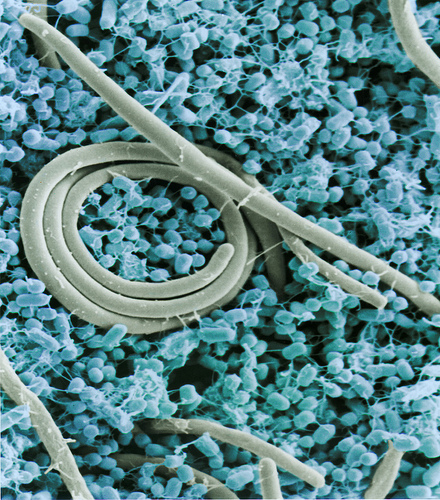Dr. Regina Tan says three words best describe her work at USDA’s Food Safety and Inspection Service: “I save lives.” As Director of the Applied Epidemiology Division for FSIS’s Office of Public Health Science, Dr. Tan and her staff are responsible for detecting health hazards in food, like disease-causing bacteria, allergens, strange objects, or diseases humans can catch from animals.
“This job is very personal to me. I have a son who depends on me to make sure he is safe. I think of this work by putting the faces of my family to it,” Dr. Tan has said. Read more »

Colorized SEM (scanning electron micrograph) of the foodborne pathogen Salmonella enteritidis. Photo by Jean Guard, ARS.
This post is part of the Science Tuesday feature series on the USDA blog. Check back each week as we showcase stories and news from USDA’s rich science and research profile.
When it comes to microorganisms that contaminate our foods, you may think it’s a veritable jungle out there—but in fact, in the United States, most of the illnesses, hospitalizations and deaths caused by foodborne pathogens come down to 14 bad players. Read more »
Cross posted from the White House blog:
With the holiday season in full swing, many of us are thinking about the meals we’ll soon be sharing with family and friends. Whether it’s turkey and egg nog, or latkes, or a New Year’s buffet, food is always a central and cherished part of the festivities. Of course, we all know that a necessary ingredient for any meal is food safety.
When the President came into office, he said that “protecting the safety of our food and drugs is one of the most fundamental responsibilities government has.” He pledged to strengthen our food safety laws and to enhance the government’s food safety performance. Read more »
National Preparedness Month is a good opportunity to reflect on progress towards ensuring the security of our Nation’s food supply. The U.S. Department of Agriculture (USDA) considers defense of the food and agriculture sector critical– all the way from farm to fork. Some animal or plant diseases could have drastic consequences on our economy – yet another reason it’s important that we continue our efforts to improve food and agricultural emergency preparedness and response.
You probably are familiar with many of the USDA agencies whose animal, plant and or food inspection programs have touched your life at some point whether traveling or simply buying meat or poultry sold in grocery stores.
For example, USDA’s Food Safety and Inspection Service (FSIS), Animal and Plant Health Inspection Service (APHIS) and National Institute of Food and Agriculture (NIFA) enhance agricultural security through numerous programs. These programs range from inspecting native and foreign agricultural products, to evaluating food system vulnerabilities, to maintaining laboratory networks that can rapidly identify diseases and pests. To illustrate, some of our efforts over the last year include: Read more »
Tags: agrosecurity, APHIS, ARS, CDC, DHS, FDA, FSIS, National Animal Health Laboratory Network, National Plant Diagnostic Network, National Preparedness Month, National Veterinary Stockpile, NIFA
 Food Safety, Plant and Animal Health, Science
Food Safety, Plant and Animal Health, Science
Here in Washington, D.C., and probably where you live too, it is hot! This week’s Check Your Steps blog focuses on a timely food safety step—Chill. You may feel like this guy, but in reality we don’t recommend keeping your food cold with fans, no matter how many you can find.
Bacteria grow rapidly between 40 °F and 140 °F, and when it’s above 90 °F outside, cold food heats to those temperatures much faster. Portable coolers can be your best friend during outdoor summer activities or grocery shopping, but pack them correctly to keep food at 40 °F or below so it doesn’t spoil or make you sick. Read more »
For the past two Tuesdays as part of the Food Safe Families campaign, I’ve blogged about two basic food safety steps that are important but easy to implement in your food prep routine—cook and clean. Today, I’m going to focus on preventing a sneaky food safety hazard that can happen at many points between purchasing and eating food: cross-contamination.
Cross-contamination occurs when juices from uncooked foods come in contact with safely cooked foods, or with other raw foods that don’t need to be cooked, like fruits and vegetables. The juices from some raw foods, like meats and seafood, can contain harmful bacteria that could make you and your family sick. Read more »

